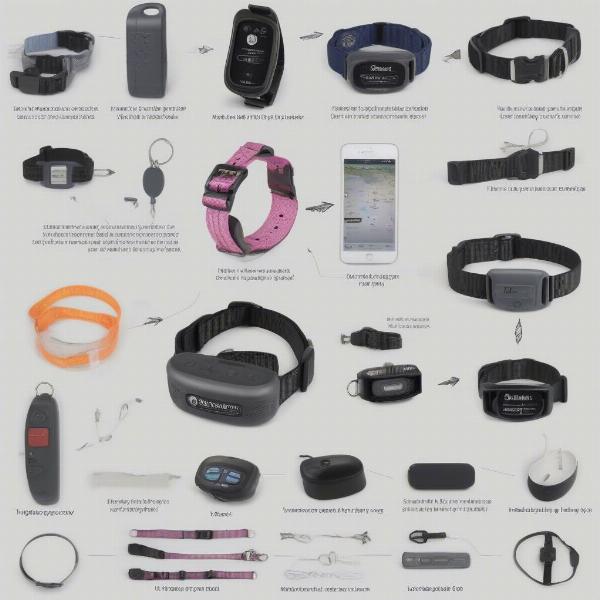Choosing the right ecollar for your dog can be a daunting task, especially with so many options available. This guide will help you understand what ecollars are, how they work, and what to look for when choosing the best one for your furry friend. Whether you’re looking to improve training, enhance safety, or manage unwanted behaviors, understanding the nuances of best dog ecollars is crucial for responsible and effective use.
Understanding Dog Ecollars: What Are They and How Do They Work?
Ecollars, also known as electronic collars or training collars, are devices designed to provide remote training and behavior modification for dogs. They utilize a transmitter held by the owner and a receiver collar worn by the dog. The transmitter sends signals to the receiver, which delivers various stimuli to the dog. These stimuli can include vibrations, beeps, or static stimulation. While the term “shock collar” is often used, modern ecollars prioritize humane and effective training methods, with static stimulation being a last resort. Choosing the best dog ecollar involves understanding your dog’s temperament, training goals, and the specific features of each collar.
 Different Types of Dog Ecollars
Different Types of Dog Ecollars
The effectiveness of an ecollar relies heavily on proper usage and training. It’s not a magic solution but a tool that, when used correctly, can aid in communication and reinforcement.
Key Features to Consider When Choosing the Best Dog Ecollar
Finding the best dog ecollar requires careful consideration of several factors. These include:
- Stimulation Levels: Look for collars with a wide range of stimulation levels, allowing you to adjust the intensity to your dog’s sensitivity. Start with the lowest level and gradually increase only if necessary.
- Types of Stimulation: Many ecollars offer various stimulation types, including vibration, beep, and static stimulation. Consider which type is most suitable for your dog’s temperament and training needs.
- Range: The range of the ecollar determines how far away you can be from your dog while still maintaining control. Choose a range that suits your training environment and activities.
- Waterproof and Durability: If your dog enjoys swimming or playing in wet conditions, a waterproof and durable ecollar is essential.
- Battery Life: A long-lasting battery ensures uninterrupted training sessions. Consider the battery type and charging options.
- Collar Size and Fit: Ensure the collar fits your dog comfortably and securely. Adjustable collars are ideal for growing dogs.
Best Dog Ecollars for Different Needs
Different dogs have different needs, and understanding your dog’s specific requirements is key to selecting the best ecollar.
Best Dog Ecollars for Small Dogs
Small dogs require ecollars designed specifically for their size and sensitivity. Look for lightweight collars with lower stimulation levels.
Best Dog Ecollars for Large Dogs
Larger, more energetic breeds might require ecollars with a longer range and more robust construction.
Best Dog Ecollars for Bark Control
Specialized bark control collars utilize sensors to detect barking and deliver a correction.
Training Your Dog with an Ecollar: Tips and Best Practices
Using an ecollar effectively requires patience, consistency, and positive reinforcement.
- Start with the Basics: Begin with basic obedience commands like sit, stay, and come.
- Pair the Ecollar with Positive Reinforcement: Use treats and praise to reward desired behaviors.
- Consistency is Key: Use the ecollar consistently and fairly to avoid confusion.
- Consult a Professional Trainer: If you’re unsure about how to use an ecollar properly, consult a certified dog trainer.
Choosing the Right Ecollar: Avoiding Common Mistakes
Avoid these common mistakes when choosing and using an ecollar:
- Using the Ecollar as Punishment: Ecollars should never be used as punishment. They are tools for communication and reinforcement.
- Starting with High Stimulation Levels: Always begin with the lowest stimulation level and gradually increase only if necessary.
- Overusing the Ecollar: Use the ecollar sparingly and only when necessary. Focus on positive reinforcement methods.
Conclusion
Finding the best dog ecollar involves understanding your dog’s individual needs, training goals, and the features of each collar. When used responsibly and in conjunction with positive reinforcement methods, ecollars can be valuable tools for training, safety, and behavior modification. Remember to prioritize your dog’s well-being and consult with a professional trainer if you have any questions or concerns.
FAQ
- Are ecollars safe for dogs? When used correctly and humanely, ecollars are safe for dogs.
- How do I choose the right stimulation level for my dog? Start with the lowest level and gradually increase only if necessary. Observe your dog’s reaction.
- Can I use an ecollar on a puppy? Consult with a veterinarian or professional trainer before using an ecollar on a puppy.
- Are there any alternatives to ecollars? Positive reinforcement methods like clicker training and reward-based training are excellent alternatives.
- How often should I use an ecollar? Use the ecollar sparingly and only when necessary. Focus on positive reinforcement.
- What should I do if my dog reacts negatively to the ecollar? Stop using the ecollar immediately and consult with a veterinarian or professional trainer.
- Can I use an ecollar for aggression? Consult with a professional dog trainer or behaviorist before using an ecollar for aggression.
ILM Dog: Your Expert Resource for Dog Care
ILM Dog is your trusted source for comprehensive and expert advice on all aspects of dog care, from breed selection to training, health, and nutrition. We are dedicated to providing practical and up-to-date information to help you provide the best possible care for your canine companion. Whether you’re a new dog owner or a seasoned expert, ILM Dog offers valuable resources to help you navigate every stage of your dog’s life. Contact us for personalized guidance and expert recommendations: Email: [email protected], Phone: +44 20-3965-8624.